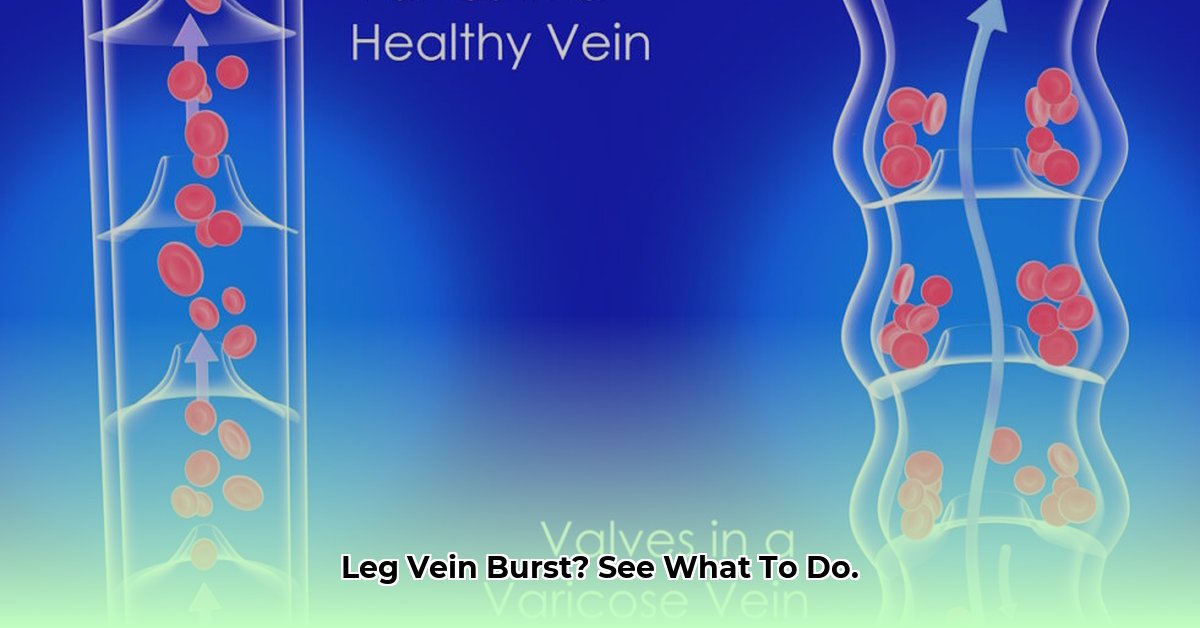This guide provides clear, concise information about burst blood veins in the leg, covering symptoms, causes, treatment, and prevention. While most cases are harmless, understanding the signs and when to seek medical attention is crucial.
Recognizing a Burst Blood Vein
Have you noticed a reddish-purple mark under your skin? It might be a burst blood vein, also known as a ruptured capillary. These marks, ranging from tiny red dots (petechiae) to larger purplish patches (purpura) or branching lines (spider veins), occur when small blood vessels leak into surrounding tissue. A hematoma, a larger collection of blood under the skin, may also result, often appearing as a raised, tender bump. The color can change over time, shifting from red, blue, and purple to green and yellow as the body reabsorbs the blood. This color change is a normal part of the healing process. Accompanying a burst vein, you may or may not experience slight tenderness or mild pain around the colored spot. These sensations will often resolve with little or no treatment.
Understanding the Causes
Several factors can cause a blood vessel to burst in your leg, ranging from everyday occurrences to underlying medical conditions.
- Trauma: A simple bump, bruise, or minor injury can cause capillaries to rupture.
- Venous Insufficiency: This condition occurs when valves in the leg veins weaken, hindering blood flow back to the heart. The resulting pressure can cause capillaries to burst.
- High Blood Pressure: Elevated blood pressure can stress blood vessels throughout the body, making them more susceptible to rupture.
- Aging: As we age, blood vessels become more fragile and prone to bursting.
- Sun Exposure: Excessive sun exposure can weaken blood vessels, similar to how it damages skin and causes wrinkles.
- Other Factors: Obesity, prolonged standing or sitting, certain medications (especially blood thinners), and medical conditions like diabetes can also increase the risk.
A table summarizing these causes and their associated symptoms can be found below:
| Potential Cause | Possible Symptoms |
|---|---|
| Trauma | Bruising, localized swelling, pain at the injury site |
| Venous Insufficiency | Varicose veins, swelling, leg heaviness, aching |
| High Blood Pressure | Often no visible symptoms in the legs until a rupture occurs |
| Aging | Increased bruising, spider veins |
| Prolonged standing/sitting | Swelling, aching, increased visibility of spider veins |
| Obesity | Increased pressure on leg veins, swelling, varicose veins |
First Aid and Treatment
Most burst blood veins are minor and heal within a few days to a couple of weeks. Simple self-care measures can help:
- R.I.C.E.: Rest, Ice, Compression, Elevation. Rest the leg, apply a cold compress (wrapped in a towel) for 15-20 minutes several times a day, and elevate the leg above your heart. Compression stockings can also be beneficial.
- Over-the-Counter Pain Relief: Ibuprofen or acetaminophen can help with any discomfort.
Step-by-Step First Aid
- Elevate: Prop your leg up, preferably higher than your heart, to reduce blood flow to the area.
- Cool: Apply a cold compress wrapped in a towel to the area for 15-20 minutes several times a day.
- Compress: If comfortable, use a compression bandage.
- Rest: Avoid strenuous activity involving the affected leg.
When to See a Doctor
While most cases are harmless, consult a doctor if you experience:
- Severe pain
- Significant swelling
- Signs of infection (redness, warmth, pus, fever)
- Bleeding that doesn’t stop with direct pressure
- Sudden appearance of numerous marks
- Marks that don’t fade within a couple of weeks
- Thinning skin or sores over the affected vein
Preventing Burst Blood Veins
Several lifestyle changes can help prevent future occurrences:
- Regular Exercise: Improves circulation and strengthens blood vessels.
- Healthy Weight: Reduces pressure on veins.
- Avoid Prolonged Standing/Sitting: Get up and move around frequently to promote blood flow.
- Compression Stockings: Provide support and improve circulation.
Related Conditions and Ongoing Research
A burst blood vein can sometimes be related to other venous conditions like varicose veins, spider veins, or, less commonly, deep vein thrombosis (DVT). Recurring ruptures warrant consultation with a healthcare provider. Ongoing research continually expands our understanding of vascular health, exploring potential contributing factors like nutritional deficiencies and investigating new treatments like laser therapies.
Frequently Asked Questions
- Are all burst blood veins serious? No, most are minor and heal on their own. However, some can indicate underlying conditions requiring medical attention.
- How long does healing take? Typically, a few days to a couple of weeks.
- Can compression stockings help? Yes, they support leg veins and improve circulation, reducing the risk of bursts.
Important Note: This information is for educational purposes only and does not substitute for professional medical advice. Always consult a healthcare provider for diagnosis and treatment. They can accurately assess your situation and recommend the most appropriate course of action.
- Glass Lunch Box Containers Offer Healthy, Leak-Proof Meal Prep - December 21, 2025
- Glass Bento Boxes Offer a Healthy, Eco-Friendly Lunch Solution - December 20, 2025
- Glass Bento Containers Make Packing Lunch Easier and Healthier - December 19, 2025










